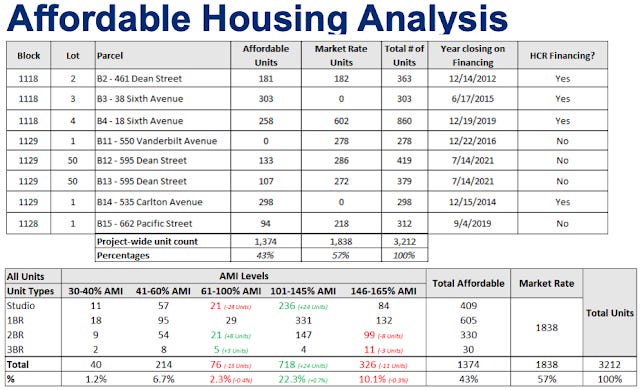What Affordable Housing Graphics Conceal--or Reveal
A New York State chart on Atlantic Yards affordability only tracks categories; a new graphic shows the rising costs.
I wrote last month about how Empire State Development, the state authority that oversees/shepherds the project, had revised an affordable housing chart produced at the request of the advisory Atlantic Yards Community Development Corporation.
Yes, it’s a useful chart, showing the total number of units, the timing, the division between market-rate and affordable units, and the different income categories, or “bands,” among the latter. It also shows unit sizes.
Where it falls short—and, yes, it’s already a complex chart!—is in telling us what the units actually cost, and to whom they were available.
Noticing the trend
That’s why a graphic produced by Ben Keel for my recent Atlantic Yards overview in Urban Omnibus is so valuable. (It’s headlined Watch This Space or, in my working title, “Whatever Happened to Atlantic Yards?”)
Note that the chart only looks at two-bedroom units, but it’s still broadly representative of income ranges and relative costs.

It shows that, while the first three buildings with affordable units contained a range of income “bands," the most recent four buildings are limited to apartments at 130% of Area Median Income, or AMI. That’s enabled by the now-expired 421-a tax break.
Rising AMI
It also shows that rising AMI means that units in the most recent buildings, despite being in Band 4 (100-140% of AMI), cost more than Band 5 apartments in the first three buildings.
The inset shows that AMI has more than doubled since 2006, when the project was approved. The New York City AMI is distorted by the inclusion of several suburban counties and a calculation known as the High Housing Cost Adjustment.
A policy change re AMI?
That’s what, as I reported last month, Rep. Yvette Clarke (D-Brooklyn) and Sen. Kirsten Gillibrand (D-NY), with colleagues, introduced the Affordable Housing and Area Median Income Fairness Act of 2024.
It would direct the federal Department of Housing and Urban Development (HUD) “to conduct an assessment of more inclusive calculation methods of the AMI, as well as to submit a report to Congress detailing its post-assessment findings and recommendations for reforming or eliminating the use of AMI.”
It also would require "an analysis and assessment of the effects that high housing cost adjustments have had on income limits and rent prices," and "an updated assessment of the potential impacts to affordable housing, particularly on income limits and rent prices, of calculating area median income on a ZIP Code-level basis and using other localized methodologies."
It also requires an assessment of the impacts that the inclusion of Westchester and Rockland Counties has on New York City's AMI and affordable rents.






